Quick Summary: This blog moves your focus to improving patient access and involvement in their health information. It includes the meaning of telehealth solution, its benefits, the working of telehealth solution, features, types, and future technology trends. This is not it with the help of telehealth solution healthcare professionals can devote their attention to more critical cases that require direct involvement.
COVID has brought a significant transformation to the healthcare industry, as the isolation people experienced spurred the development of new technologies, flexible consulting options and innovative care delivery methods aimed at ensuring patient access.
In 2022, the statistics showed that only 1 in 5 patients reported their inaccessibility to their healthcare data. In the current situation, it shows a remarkable improvement, with over 50% of individuals nationwide able to access their health information online.
This trend highlights a considerable advancement in patient access to electronic health information over the last decade.
Telehealth Solution Development: Improving Access to Care and Patient Engagement
In modern-day healthcare practices, enhancing access to patient health information has significantly improved patient engagement. This development has motivated patients to proactively participate in their care delivery while boosting better collaboration and communication among providers.
Such improvements contribute to the delivery of more comprehensive and holistic care.
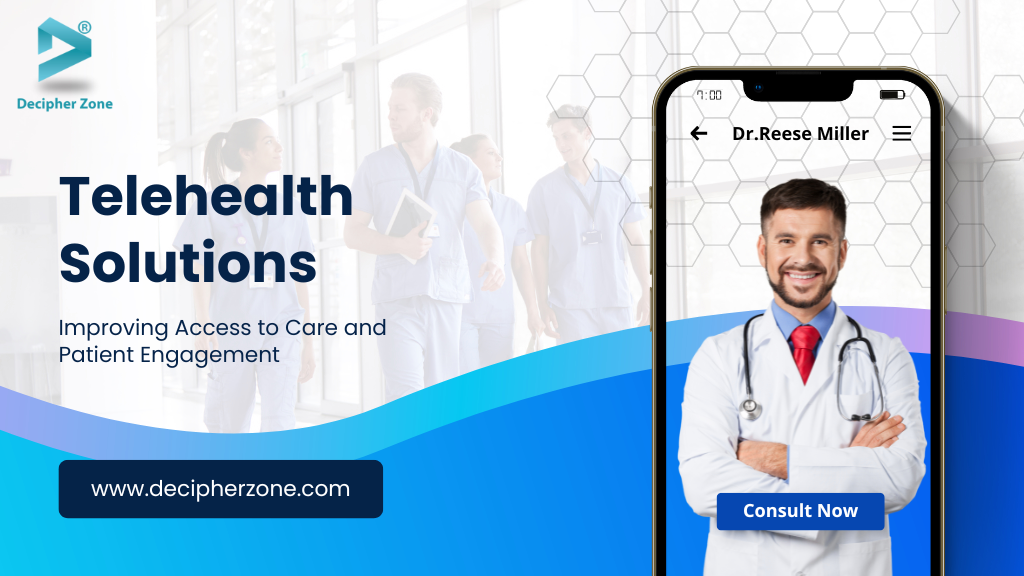
Even though patient portals are available, only about 30% of patients actively use them to manage their healthcare, according to a report by the GAO. However, there’s a silver lining: telehealth platforms have the potential to tackle these issues and significantly boost patient engagement.
You may wonder how telehealth can enhance patient engagement. Well, in this blog, we will explore all the aspects of telehealth solutions.
What is Telehealth Software Solution
Telehealth software solutions leverage technology to deliver health services, education/ training and healthcare information anywhere in the world, using telecommunications technology like video calls, phone consultations, and online communications.
Telemedicine solutions focus more on clinical services whereas telehealth solutions covers a broader range of healthcare services. The healthcare professional can train healthcare staff, engage and educate patients about the preventive healthcare topic online and monitor the recovery even after hospital discharge.
The main focus of many of these telehealth solutions is to make healthcare and information services more convenient and efficient and increase the quality of patient care and patient engagement. This tool not only makes healthcare and health education more accessible but also makes it available to all parts of the world.
Read: The Role of IT in Healthcare Solutions
Top Most Popular Telehealth Solution Specialties
Here are some of the most popular telehealth solution specialties you can include:
-
Teleradiology
-
Telepsychiatry
-
Teledermatology
-
Telenephrology
-
Teleobstetrics
-
Teleoncology
-
Teleophthalmology
-
Telerehabilitation
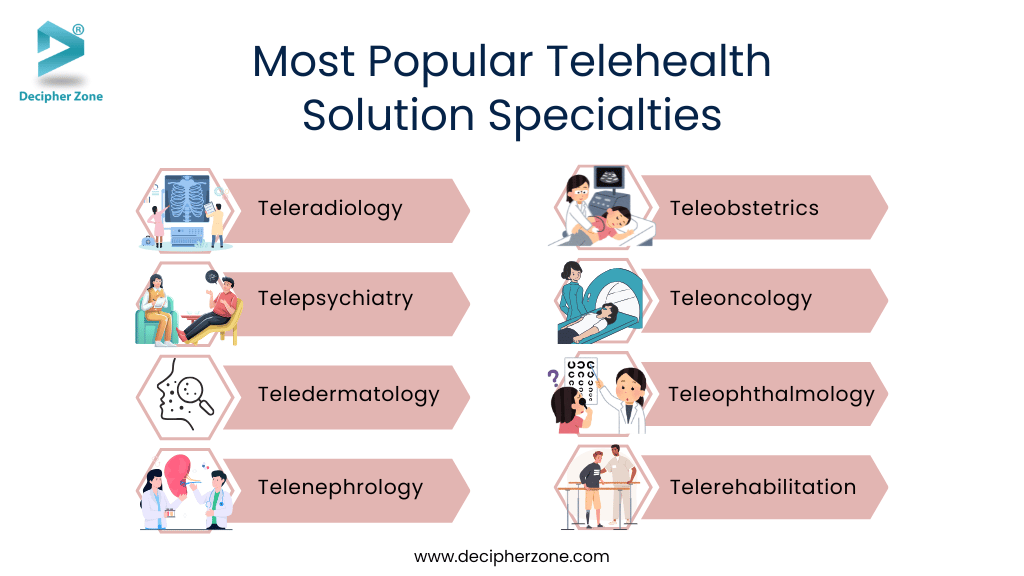
-
Teleradiology: involves the use of telecommunication technology to transmit and view radiological images.
-
Telepsychiatry: leverages technology to deliver psychiatric care remotely, including evaluation, therapy for individuals, groups, families, medical management and patient education.
-
Teledermatology: allowing patients to access dermatological care including diagnoses and treatment for skin conditions without needing in-person visits.
-
Telenephrology: leverages technology to deliver kidney care to support long-distance clinical health, patient education and healthcare administration.
-
Teleobstetrics: leverages technology to manage chronic gynecological conditions (menstrual disorders, infertility, menopause). This tool also provide obstetric care like offering virtual prenatal visits, follow-up for high risk pregnancies and postpartum care.
-
Teleoncology: to deliver cancer care services and offer patients quality treatment from top oncologists and specialists, without the need to wait for appointments and visits to centers.
-
Teleophthalmology: leverage telecommunication technology and digital medical equipment to deliver eye care, enabling access to eye specialists, screening, diagnosis and monitoring of eye conditions mostly in underserved areas.
-
Telerehabilitation: leverage technology to deliver rehabilitation services to ease information gathering and communication, assessment, prevention, treatment, education and counseling.
Read: Medical Imaging Software Development
Top 6 Advantages of Telehealth Software Solutions Development
Here’s more to the list of top benefits in detail:
-
Seamless Integration With Existing Systems
-
Secure HIPAA Compliant HD Video
-
No Waiting Rooms or Travel Hassles
-
Improved Patient Satisfaction
-
More Efficient and Purpose-Driven Visits
-
Enhanced Communication & User Experience
Modern telehealth solutions go beyond basic video calls, presenting various advantages including better access to care, increased patient engagement and lower healthcare costs. This tool enhances both the patient and provider experience.
1. Seamless Integration With Existing Systems:
Telehealth solutions are designed to integrate effortlessly with Electronic Health Records (EHRs), practice management software, mobile applications and patient portals. This ensures a smooth and streamlined workflow with no need for duplicate data entry, saving time for providers and reducing errors.
2. Secure HIPAA Compliant HD Video:
Patients and providers can connect through high-quality, encrypted video calls from any web-enabled device. This not only ensures confidentiality, face-to-face interactions but supporting continuity of care and patient comfort.
Read: Dental Software Development
3. No Waiting Rooms or Travel Hassles:
Patients can join virtual appointments directly from their devices without the need to travel or sit in waiting rooms. This is especially beneficial for users with mobility issues, chronic conditions or tight schedules.
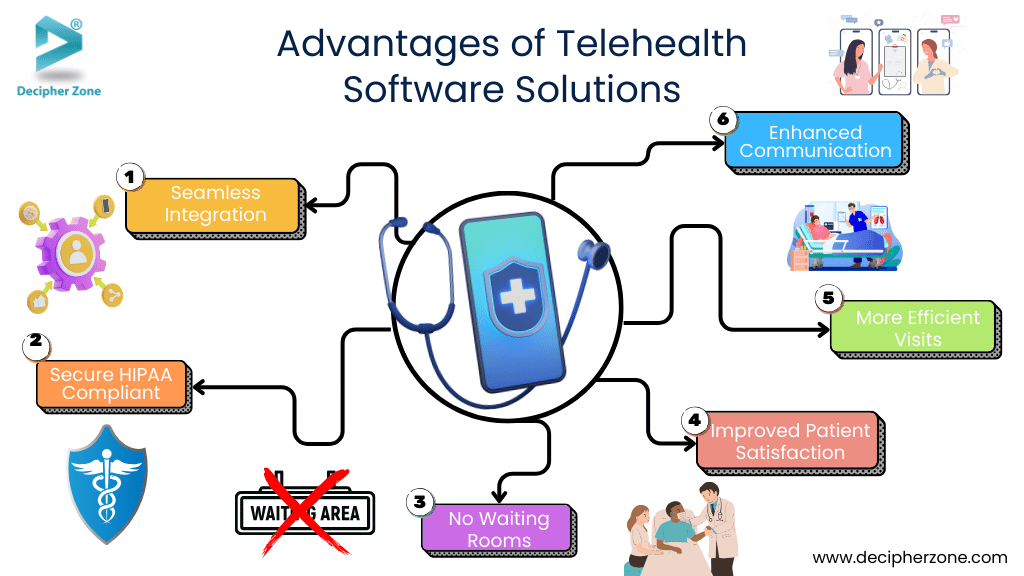
4. Improved Patient Satisfaction:
Patients nowadays prioritize convenience. Telehealth solutions provide a fast, flexible and user-friendly experience. This helps to build trust, strengthen provider-patient relationships and improve overall satisfaction with care delivery.
5. More Efficient and Purpose-Driven Visits:
Virtual visits are ideal for a wide range of services including initial screenings, follow-ups, patient education, reviewing test results, medication management and mental health consultations. This helps free up in-person visits for more critical cases.
6. Enhanced Communication & User Experience:
Patients receive timely email notifications for appointment reminders, visit summaries, prescriptions and medical notes. Providers are instantly notified about new appointments, requests or follow-up actions ensuring a smooth and responsive care cycle.
Read: Telemedicine App Development
How Does Telehealth Software Solution Work?
Here is the detailed process of how the telehealth solution functions:
-
Appointment Scheduling and Patient Notifications
-
Secure Access to Virtual Visits
-
Real-Time Patient-Provider Interaction
-
Real-Time Patient-Provider Interaction
-
EHR Integration and Clinical Documentation
-
Billing, Prescription & Follow-Up
The telehealth software solution is built to simplify how patients and healthcare providers connect via the web. From initial appointment scheduling to post-visit follow-ups, every step is designed to be intuitive, secure and fully integrated into existing clinical workflows.
1. Appointment Scheduling and Patient Notifications
Telehealth solution initially offers the ability to schedule virtual appointments through the provider’s website, patient portal or even a mobile application. Once scheduled the system sends automated reminders via email or text to ensure the patient is prepared for the upcoming consultation.
Our telehealth solution allows custom appointment settings, calendar syncing and automated notification flows to reduce no-show rates and enhance user engagement.
Read: Healthcare App Development
2. Secure Access to Virtual Visits
Patients can join the virtual session using a secure link (no software download is required). The platform can be browser-based and compatible with any device equipped with a camera and microphone. We build HIPAA-compliant systems that ensure end-to-end encryption and patient data privacy, supporting access across desktops, tablets and smartphones.
3. Real-Time Patient-Provider Interaction
Through high-quality video interface providers can interact with patients in real-time, review their symptoms, access medical history and provide recommendations just as they would during an in-person appointment.
Our video modules are optimized for clarity, low latency and dynamic layouts allowing physicians to simultaneously interact and document within the EHR system for future reference and record.
Read: Healthcare Inventory Management Software Development
4. EHR Integration and Clinical Documentation
Providers can document the visit directly within the Electronic Health Record (EHR) during or after the call. The telehealth software is fully integrated which allows seamless access to patient records, medication lists, lab results and more.
We ensure interoperability with major EHR systems allowing structured data capture and workflow automation for reduced administrative overhead.
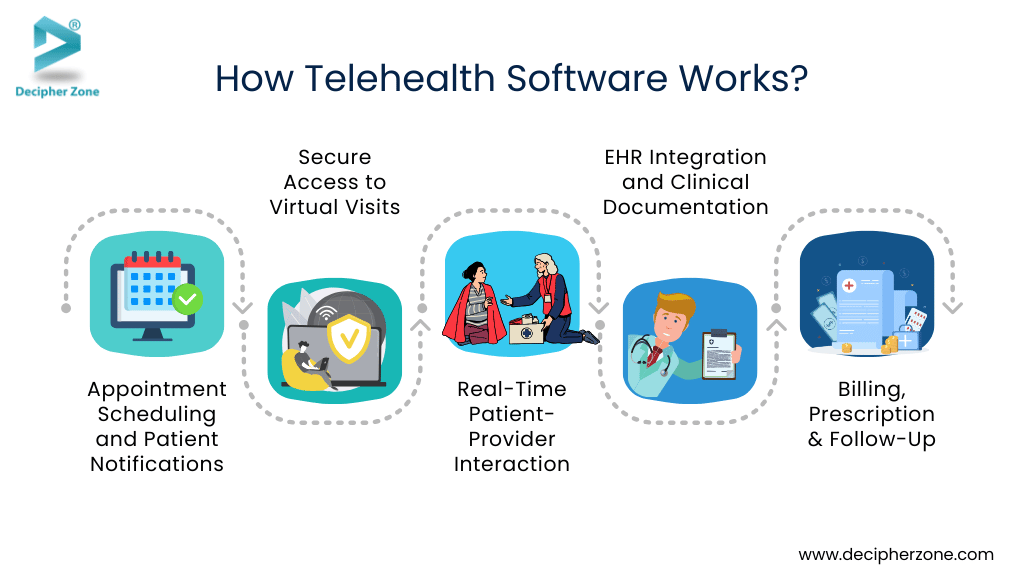
5. Billing, Prescription & Follow-Up
Prescription, visit summaries and follow-up instructions are shared with the patient through the portal or email after the session is over. The platform automatically handles billing and coding according to telehealth-specific guidelines.
Our solutions support automated claims processing, e-prescription services and customized patient communication tools. This ensures a smooth post visit experience.
Top Features to be Integrated in Advanced Telehealth Software Solution Development
Here are the core features that make telehealth solutions essential in the competitive market:
-
Enhanced Access to Care
-
Online Appointment Scheduling
-
Secure Notifications & Messaging
-
Integrated Practice Management
-
Customizable Video Interface
-
Mobile-Friendly Telemedicine
-
Seamless EHR Integration
-
Full-Embedded Platform
-
Smart Billing Integration
Telehealth software solution is transforming the way healthcare is delivered by offering a vast range of features that improve accessibility, streamline operations and enhance the overall patient experience.
1. Enhanced Access to Care
Access to timely treatment remains a concern for elderly patients, individuals in rural areas and those with chronic conditions. Delays in treatment can pose major health risks.
Our telehealth solutions are designed to bridge these gaps by enabling remote consultations, preventative care screening, physical therapy sessions and mental health services, from anywhere with an Internet connection even from the comfort of home.
This helps reduce travel barriers, lower wait times and ensures that patients receive consistent, quality care regardless of location.
Read: Healthcare App Development Cost
.avif)
2. Online Appointment Scheduling
Long wait times and scheduling conflicts are common issues in healthcare centers. Telehealth platforms solve these problems through easy-to-use online appointment scheduling.
Patients can book appointments at their convenience, receive automated reminders and get real-time updates all of which help reduce missed visits and improve time management for both patients and providers. Patient records and scheduling details are securely stored in compliance with HIPAA regulations.
3. Secure Notifications & Messaging
Communication is crucial for effective virtual care. Our platform includes secure, HIPAA-compliant messaging features and teleconferencing capabilities that allow providers and patients to interact via text, audio or video.
Real-time chat and high-definition video consultations create a personalized experience. The system supports group visits with multiple providers and works seamlessly on both web and mobile devices. This ensures flexibility and convenience.
4. Integrated Practice Management
There are two critical healthcare operations: effective data handling and administrative efficiency. Our telehealth solution integrates practice management tools that streamline documentation, automate workflows and reduce manual entry.
It also includes built-in cybersecurity protocols to protect sensitive patient information and minimize the risk of data breaches. Around-the-clock support is available to ensure smooth operation and quick resolution of any technical issues.
.avif)
5. Customizable Video Interface
This feature allows providers to adjust the video window to suit their needs to enhance the consultation experience. They can enlarge it for closer patient observation and minimize it to focus on documentation all while maintaining eye contact. This flexibility supports a more natural interaction and a more productive visit.
Read: On-demand Medicine Delivery App
6. Mobile-Friendly Telemedicine
Modern patients increasingly seek healthcare solutions that seamlessly integrate into their daily routines. Our mobile-friendly healthcare applications allow individuals to access medical consultations directly from their smartphones or tablets making healthcare more accessible and efficient.
Read: Top 10 Healthcare Business Ideas for Startups
From urgent care, preventive checkups, medicaid services to occupational therapy patients can connect with providers from anywhere. The platforms also supports secure data sharing. This allows continuity of care no matter where the patient is located.
7. Seamless EHR Integration
Interoperability is essential for practices managing care across multiple departments or facilities. Our telehealth software integrates directly with Electronic Health Record (EHR) systems.
This allows smooth information flow and eliminates the need for redundant data entry. Telehealth solutions improve care coordination, reduce the risk of documentation errors and allow providers to focus more on patient care rather than administrative tasks.
Read: Impact of Digital Transformation in the Healthcare
8. Full-Embedded Platform
Our telehealth solution offers a fully embedded experience from scheduling and consultation to billing within a unified system. There is no need for additional vendors or third party tools.
Our telehealth solution streamlines workflow and allows providers to conduct complete telehealth visits without switching platforms, saving time and reducing complexity.
.avif)
9. Smart Billing Integration
Our solutions include integrated billing tools that automatically apply the correct coding for telehealth visit types to support operational efficiency. This allow accurate reimbursement, minimizes billing errors and reduce administrative burden for healthcare staff.
Read: Life Sciences Consulting Services and Solutions
Top 5 Types of Telehealth Software Solutions Development
Here are the most common types of telehealth software solutions:
-
Asynchronous Telehealth
-
Remote Patient Monitoring (RPM)
-
Mobile Health (mHealth) Solutions
-
Real-Time Telehealth (Synchronous Telehealth)
-
Distance Medical Consultation & Provider Education
In line with the organization’s focus they provide telehealth software and a range of tools tailored to various specialties. This offering may concentrate on a specific niche or a particular mode of telehealth service.
The mode of telehealth can have different ways in which the providers can share health information and engage with patients, physicians and other healthcare staff.
1. Asynchronous Telehealth
This telehealth technology has another name “Store and forward telehealth”. This type of solution allows healthcare providers to share patient medical images, videos or health information with a physician at a different location.
This method doesn’t require real-time interaction but allows specialists to review information at their convenience. It’s especially beneficial in radiology, dermatology and ophthalmology where visuals like X-rays or skin photos are crucial.
Store and forward solutions are ideal for remote or underserved areas where specialist access is limited and help reduce patient wait times while improving diagnostic efficiency.
Read: Virtual Hospital Software Development
2. Remote Patient Monitoring (RPM)
RPM allows doctors to monitor vital signs, blood pressure, glucose levels and more using digital tools and devices to collect health data from patients outside of traditional healthcare clinic centres.
The data is transmitted securely and automatically to the provider, reducing the need for frequent in-person visits. This continuous monitoring helps detect issues early, improves treatment adherence and supports better long-term outcomes.
Remote Patient Monitoring (RPM) common for chronic disease management is helpful for elderly patients, those with mobility issues or individuals recovering from surgery.
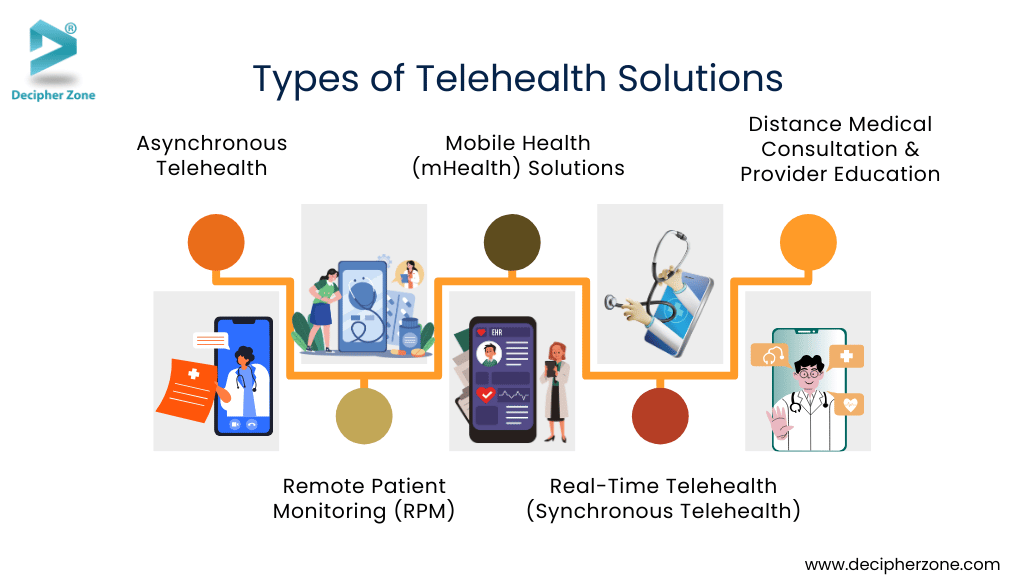
3. Mobile Health (mHealth) Solutions
Mobile health or mHealth is often app-based delivering healthcare services and information via mobile devices like smartphones and tablets. These solutions can include features such as appointment scheduling, medication reminders, live video consultations and health education tools.
mHealth encourages patients to take control of their health and stay connected to their care providers. It’s particularly effective for improving engagement and communication.
This approach is the fastest-growing area in telehealth due to the widespread adoption of smartphones and the increasing demand for accessibility.
4. Real-Time Telehealth (Synchronous Telehealth)
Real-time telehealth aka Synchronous Telehealth serves as a virtual replacement for face-to-face visits, ideal for urgent care, routine follow-ups and quick consultation.
This is a two-way interaction between patients and providers using video conferencing or phone calls. For example a patient feeling unwell can speak directly with a physician, get evaluated and even receive a prescription from the comfort of their home.
This type of telehealth is cost-effective, quick to deploy and ideal for practices looking to expand care access while reducing in-person traffic at clinics or hospitals.
Read: Building a Health Insurance App
5. Distance Medical Consultation & Provider Education
Distance medical consultations and provider education support healthcare provider collaboration and continuing education. This type of telehealth isn’t only for patient care but to let physicians consult with specialists, train staff or participate in medical conferences from anywhere in the world.
For example, a doctor in the US can provide guidance to a clinic in a remote area or conduct virtual medical training for teams in underserved countries.
These capabilities boost global knowledge sharing, rapid access to expert opinions and improve healthcare delivery across different regions even where resources and specialists are limited.
Top 5 Technology Trends to Improve Engagement in Telehealth Solutions
Here are key technology-driven strategies and future trends to enhance patient engagement in telehealth:
-
AI-Powered Chatbots
-
Gamification For Adherence
-
Wearable Devices Integration
-
Telepharmacy
-
Medical Drones
If technology trends are thoughtfully implemented digital health tools not only simplify care delivery but also improve adherence, communication and health outcomes.
1. AI-Powered Chatbots
AI chatbots are the virtual assistants within telehealth platforms that help patients navigate the digital system, book appointments or find healthcare information. These AI inbuilt systems offer 24/7 support during onboarding and beyond, answering common questions and guiding users throughout the process.
For users who are new or elderly patients unfamiliar with digital platforms AI chatbots significantly reduce confusion and ensure a smoother, more engaging and seamless virtual care experience.
Read: The Impact of AI on the Healthcare
2. Gamification For Adherence
Integrating gamification elements can boost patients’ motivation and engagement in managing their health. By adding game-like features such as badges, milestones or progress tracking to their care journey patients can feel more invested in achieving their health goals.
Whether it’s earning rewards for daily medication adherence or tracking physical therapy goals gamified telehealth interfaces boost engagement through positive reinforcement and create a more interactive care environment.
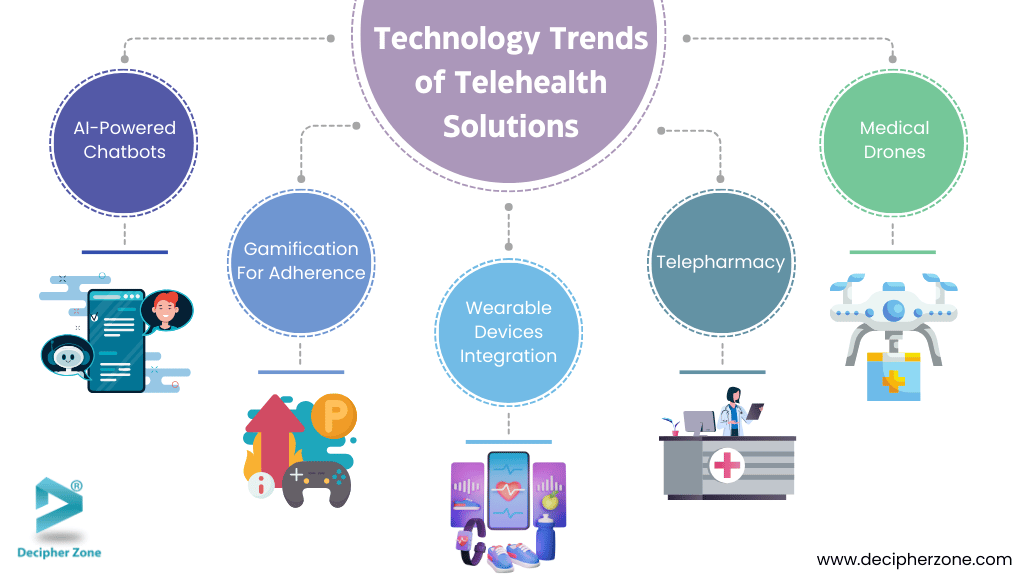
3. Wearable Devices Integration
Integrating wearable health devices enables personalized care recommendations, timely interventions and ongoing monitoring without the need for frequent visits. Telehealth platforms provide real-time health data to both patients and providers with wearable devices like smartphones, fitness trackers and blood pressure monitors.
By tracking metrics like heart rate, glucose levels or physical activity these wearable integration boosts proactive care and keep patients engaged in their wellness journey.
Read: Digital Healthcare Technology Trends
4. Telepharmacy
Telepharmacy allows patients to speak to pharmacies for advice, drug interaction alerts and medication therapy management. This type of telehealth is revolutionizing how patients receive medication guidance and pharmacy care.
Remote dispensing solutions and automated refills improve accessibility in underserved regions while tools like predictive analytics and prescription synchronization help ensure patient remain compliant with their treatment.
As medication adherence is key to managing chronic conditions, telepharmacy plays a crucial role in improving engagement and outcomes.
5. Medical Drones
Medical drones can deliver medication, vaccine and emergency equipment to remote or disaster-affected regions to ensure timely support. These drones are emerging as a transformative force in healthcare logistics particularly in areas with limited infrastructure.
Advanced drones also feature real-time communication tools for emergency care and can integrate with IoMT (Internet of Medical Things) systems to relay live health data.
By speeding up response times and improving last-mile delivery medical drones enhance both access and patient trust in telehealth systems.
Read: AI Chatbots for Healthcare Software
Adopting the latest technologies and trends isn’t just about modernization it is about creating a better experience for patients. Keeping up and integrating advancements like AI, IoMT or real-time analytics ensures your practice remains future-ready.
Offering innovative, user-friendly solutions shows your commitment to quality care which increases both patient satisfaction and engagement.
Case Studies (Real Results, Real Clients)
Our team has achieved significant milestones by creating solutions that support businesses. Below are some successful software solutions we have embarked on:
OscarEMR – Electronic Medical Records System for Improved Healthcare Delivery
Project Overview: OscarEMR is a comprehensive Electronic Medical Record (EMR) platform that supports clinicians in delivering care to over 3.5 million Canadians—and counting. Designed to enhance healthcare at both individual and population levels, the platform streamlines medical data management, facilitates better patient outcomes and promotes continuity of care.
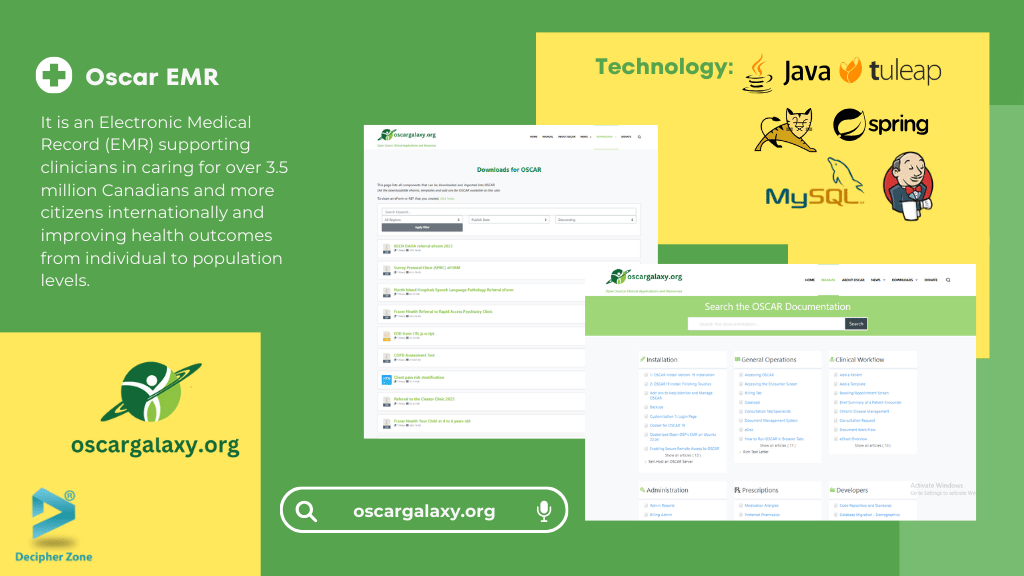
Technologies Used: Java, Tuleap, Tomcat, Spring, Struts, Hibernate, MySQL, Jenkins, JUnit, Maven.
Impact:
OscarEMR has significantly modernized healthcare practices by centralizing patient information in a secure, scalable system. Its integration with Spring, Hibernate, and Struts provides a robust backend architecture, while automated CI/CD pipelines via Jenkins and JUnit ensure reliability and performance.
It empowers healthcare professionals with faster access to accurate patient data improving diagnosis and treatment efficiency.
Calliope.pro – DevOps Test Monitoring and Reporting Tool
Project Overview: Calliope.pro is a DevOps-focused test results monitoring platform that transforms raw test outputs (in JSON or XML formats) into clear, visually compelling reports.
It enables development teams to monitor, compare, and share test results efficiently bringing transparency and alignment across the entire team from a single dashboard.
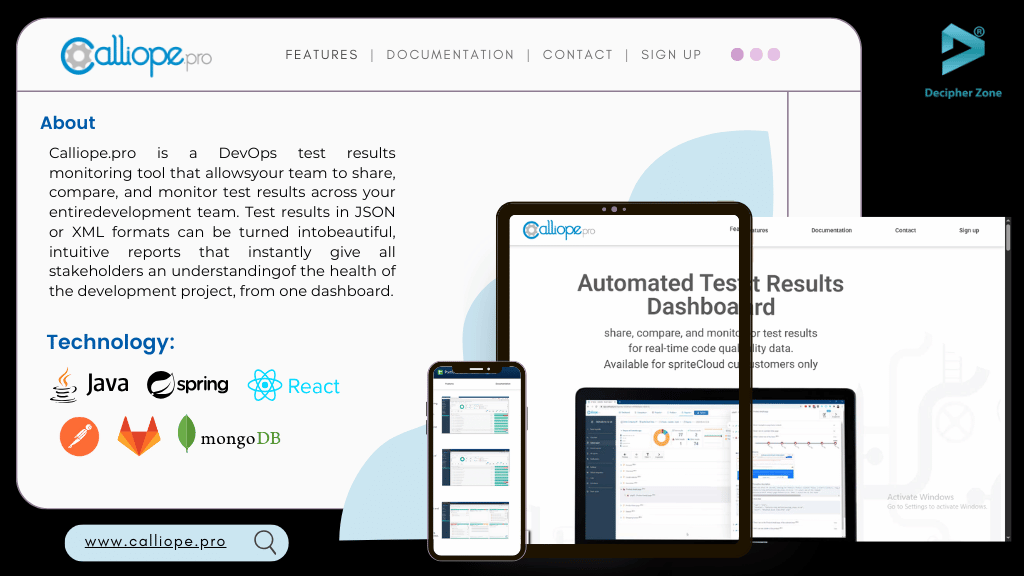
Technologies Used: (Java-based stack assumed due to formatting, please confirm if needed).
Impact:
Calliope.pro has redefined test result visualization and collaboration in DevOps environments. By centralizing and beautifying test data, it enhances team communication and provides instant insights into the project's health for all stakeholders.
This boosts efficiency, reduces time-to-resolution for bugs, and aligns QA, DevOps, and project managers with real-time updates on test performance.
Plan Finder – Healthcare Plan Comparison Tool
Project Overview: Plan Finder is an anonymous healthcare plan comparison tool provided by Connect for Health Colorado. It allows users to estimate and compare total healthcare costs across different insurance plans for an entire year, helping individuals and families make more informed decisions based on their expected healthcare usage.
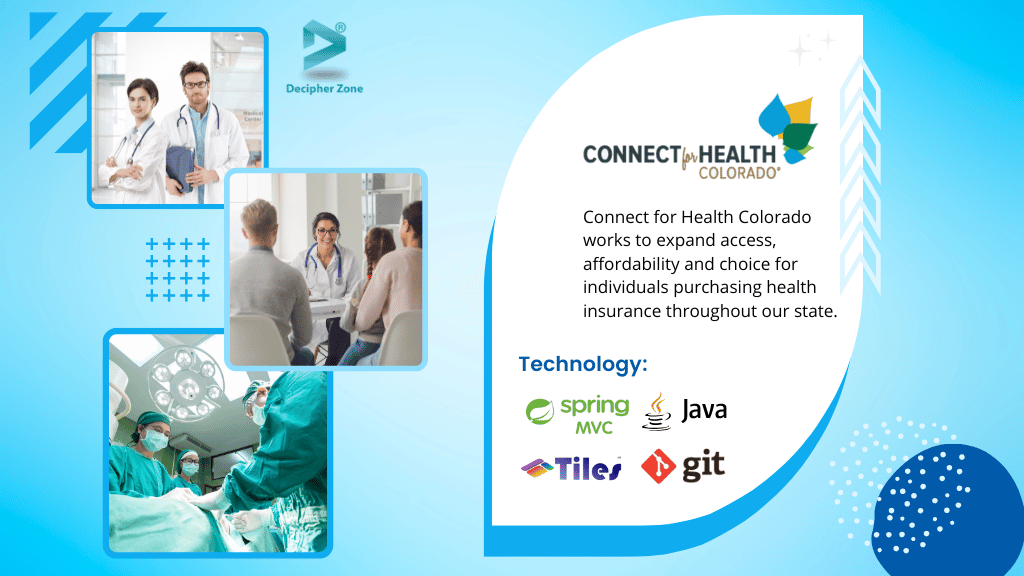
Technologies Used: Java, Spring MVC, Apache Tiles, Maven, Git.
Impact:
Plan Finder simplifies the complex process of choosing the right health insurance by offering a user-friendly interface and cost estimation engine. Built with Spring MVC and Apache Tiles, the application ensures modularity and fast performance.
Its seamless UX encourages wider usage and accessibility, empowering users to select the most cost-effective healthcare plan tailored to their specific needs.
How Decipher Zone Can Help in Telehealth Solution Development?
Our team at Decipher Zone are expert developers, designers and strategists to bring telehealth software solutions to life from initial concept to deployment, scaling and promotion.
We understand the complexities of remote healthcare delivery and offer end-to-end services that align with modern medical standards.
Here is how our team can support your telehealth journey.
End-to-end platform development
Our team builds robust telehealth platforms including web portals, mobile applications and cloud-based systems that power seamless virtual consultations, remote diagnostics and real-time health data sharing. Whether it’s small clinics or large hospital networks, we engineer scalable solutions tailored to your needs.
Intuitive user experience design
Our designer prioritizes intuitive and accessible interfaces for both healthcare providers and patients. From appointment booking to video consultations and report sharing we ensure every step is smooth, efficient and easy to use.
Security & regulatory compliance
At Decipher Zone we integrate industry-leading encryption and follow best practices to ensure your platform complies with global healthcare regulations like HIPAA and GDPR. Our goal is to protect sensitive patient data while building trust among users.
Integration
We specialize in integrating telehealth solutions with existing healthcare infrastructure such as Electronic Healthcare Records (EHRs), billing systems and wearables devices. This ensures seamless data flow, improves operational efficiency and overall care coordination.
Ongoing support & maintenance
We doesn’t end our job at deployment, we offer continuous support, updates, performance monitoring and troubleshooting to keep your telehealth solution on track, secure, reliable and aligned with technological advancements.
Technologies
Our team utilizes a robust and modern tech stack to deliver telehealth solutions.
-
Frontend Technologies: ReactJS, Angular, Vue.js, JavaScript, CSS3
-
Backend Technologies: Java, PHP, Node.js
-
Mobile Development: Native and cross-platform apps for Android and iOS
-
Databases: MySQL, MongoDB, Cassandra
-
Frameworks: Spring, Express.js, Laravel
-
Cloud & DevOps: AWS, Azure, Google Cloud, IBM Cloud, Oracle, DigitalOcean; DevOps practices for continuous integration and deployment
-
Advanced Technologies: Blockchain, Artificial Intelligence (AI), Machine Learning (ML)
-
Strategic Promotion: Apart from the development our team offers and can assist with your go-to-market strategy. We help create demo MVPs, marketing assets and product positioning to ensure your telehealth solution gets the attention it truly deserves.
Conclusion
Telehealth software solutions have redefined the healthcare experience by transforming the geographical barriers, enhancing patient engagement and streamlining care delivery.
From real-time virtual consultations to remote monitoring and integrated EHR systems these technologies are not only improving access to care but also making healthcare more patient-centric, convenient and cost-effective.
As demand continues to grow healthcare providers must invest in reliable, scalable and secure digital healthcare platforms that meet evolving patient expectations.

Our team of experts at Decipher Zone specializes in building robust telehealth platforms and custom healthcare software tailored to your unique needs.
With deep expertise in developing HIPAA-compliant, user-friendly and scalable digital solutions we help healthcare providers streamline operations, enhance patient outcomes and stay ahead in a competitive landscape.
Whether you’re planning to launch a new telemedicine application or modernize your existing healthcare infrastructure our team is here to turn vision into reality.
FAQs
What are telehealth software solutions?
Telehealth software solutions leverage technology to deliver health services, education/ training and healthcare information anywhere in the world, using telecommunications technology like video calls, phone consultations, and online communications. Telemedicine solutions focus more on clinical services whereas telehealth solutions covers a broader range of healthcare services.
How can I measure patient engagement in telehealth?
Healthcare professionals can monitor key metrics such as appointment rates, patient portal activity (including logging, secure messaging and accessed health information) and survey feedback on satisfaction and user experience. Tracking adherence to treatment plans and improvement in health outcomes provides deeper insights into how well patients are statying involved in their care through virtual platforms.
How easy is it to integrate telehealth into my existing practice?
Our telehealth solutions are designed for seamless integration into existing healthcare workflows. With intuitive user-friendly interfaces healthcare professionals can easily adopt telehealth without disrupting their day-to-day operations. From managing appointments to delivering virtual consultations our platform ensures a smooth transition to remote care. This enhances efficiency, patient access and contuinity of care without requiring major workflow changes.
What technology tools can I use to enhance patient engagement in telehealth?
There are various advanced technological trends including AI-Powered Chatbots, Gamification for Adherence, Wearable Devices Integration, Telepharmacy and Medical Drones. If technology trends are thoughtfully implemented digital health tools not only simplify care delivery but also improve adherence, communication and health outcomes.

